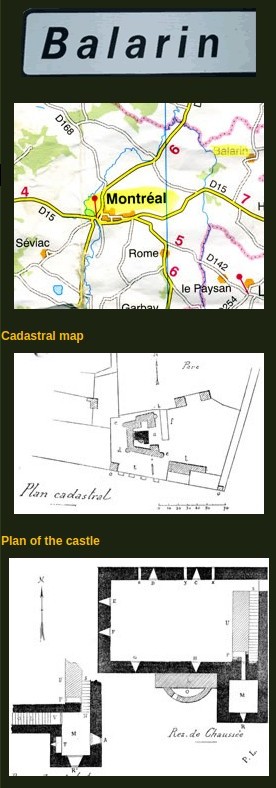
 Chateau Balarin (also written Balerin or Valerin) is located 4.5 kilometers northeast of the commune of Montréal. It dates from the thirteenth century and was situated at that time in the territory of Condom, under English control. “It was part of this system of small fortresses, all alike, spaced out along the border, linked to the east with the castles of Luzan, Beaumont, Larressingle, Pouypardin, Fousseries and Goalard above Condom, and to the west to the strondhold of Montréal, a newly established fortified town (1265).” Philippe Lauzun.
Chateau Balarin (also written Balerin or Valerin) is located 4.5 kilometers northeast of the commune of Montréal. It dates from the thirteenth century and was situated at that time in the territory of Condom, under English control. “It was part of this system of small fortresses, all alike, spaced out along the border, linked to the east with the castles of Luzan, Beaumont, Larressingle, Pouypardin, Fousseries and Goalard above Condom, and to the west to the strondhold of Montréal, a newly established fortified town (1265).” Philippe Lauzun.
The castle’s construction is typical of the Gascon chateaux of that time, in terms of its walls, the form of the loopholes, the style of its openings and its machicolated defenses. “Every one of its doors leaves the mark of this warring epoch, when fortresses rose on every hillock of Gascony, when might was right, when everywhere one felt the need to defend oneself.” Philippe Lauzun.
And so, Balarin is a fortress stretching 12 meters by 8 meters with a squared dungeon.
Beginning in the fifteenth century, the wars over, the castle was bedecked with transom windows, higher and wider, fireplaces and a stairway within a turret. These additions transformed the chateau into a more comfortable abode. An addition was also built to accommodate the outbuildings.
These add-ons are no longer visible today, and the only testimony to their existence are two water etchings by Leo Drouyn, which can be consulted in Volume II of La Généalogie de la Maison Galard by Noulens.
Moreover, as was the case for Chateau Mansencôme, a rampart was built and rebuilt several times, but it did not resist the ravages of time. As Lauzun points out, “Only the primitive castle of the thirteenth century, minus, however, its wooden skeleton and its floor boards, has remained intact, defying the ravages of time.”
In fact, the castle still gives that impression today: that of a bastion damaged but still standing proud, defying tempest and oblivion. Although Balarin was never defended by more than a single tower, in contrast with the other chateaux that often boasted two towers, one can still read in its architecture the style of the Gascon chateau. According to Lauzun, the function of this solitary tower was more one of observation than of defense.
However, its dwelling structure is characteristic of the Gascon chateaux, with its hermetically closed ground floor which served as a storehouse. One could only penetrate inside the castle through a ladder on the first floor of the tower.
A door opened from the great hall of the first floor onto the second floor, which contained a chamber for the fighters and the apartment of the seigneur and his family. This chamber was only lit by three loopholes, and it was not until the fifteenth century that two fireplaces were added to make it more comfortable.
In the thirteenth century, the castle did not exceed these two stories, which were covered with a wooden framework. A third story was later added, which leaned against the primitive parapet walk; it is has since been largely demolished.
The tower, on the other hand, had four stories which permitted it to serve as an observation post.
During the second half of the nineteenth century, the Prémontrés religiousorder built a religious edifice within the castle’s ancient rampart.
“150 meters to the north of the old castle, outside the park that surrounds it, stands the chapel, now open for the religious services of the parish, but that, entirely reconstructed in 1824, has kept nothing of its original style. Its stones still cover the graves of some of its former seigneurs.”
Philippe Lauzun.
The seigneurs of Balarin
The House of Galard
“The history of the castle of Balarin is in part that of one the branches of the house of Galard, who owned it for many centuries and whose genealogy was written by J. Noulens.” Philippe Lauzun.
The seigneurs of Galard, who doubtlessly had their beginnings at the castle of Goalard, were already cited as benefactors of the abbey of Condom as early as 1062.
In the fourteenth century, the family divided into a number of branches, including the oldest branch –that of Terraube—and the Isle-Bozon branch, from which descended the branches of Magnas, Espiens, Saldebru, Brassac, Béarn, Berac and Balarin.
In 1347, we find Viguier or Bégue de Galard cited as “Captain of the Salle de Balarin”, thus proving, as Lauzun reminds us, that Balarin was first and foremost a barracks. This same captain was also governor of Commines, regent to Princess Marguerite and a close advisor to the Count of Armagnac.
The Galard family kept possession of Balarin until 1451, at which point they sold the castle to a bourgeois and merchant from Condom named Jean Mercier. Strangely, the Galard were still around to sell Balarin yet again in 1464 to a certain Pierre Mercier, son of Jean, doubtlessly using their “buy-back right” as Lauzun calls it.
The House of Mercier
Although commoners, the Merciers were important people.
“Although commoners in origin and engaged in commerce, they possessed many houses in Condom, Montréal, Fourcès and many lands in all these districts. Their wealth was considerable. At Montréal, which seems to have been their principal place of residence, they occupied for many years the function of consul, championing with their colleagues the cause of the rights and privileges of the city.” Philippe Lauzun.
But they were also seen as “mercenary and vindictive” and were not on good terms with their neighbors.
